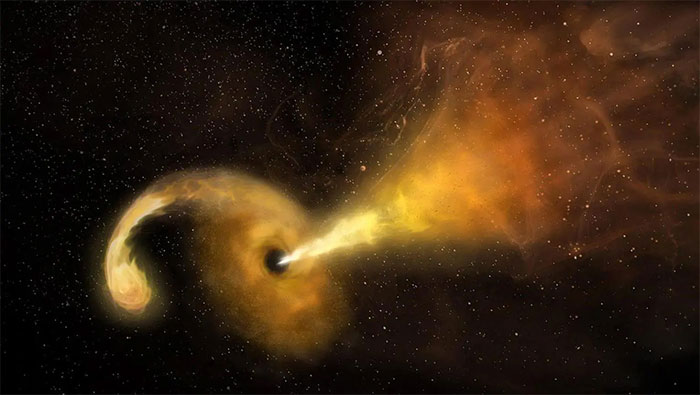Black hole is a 'time machine', object more than 13 billion years old revealed?
Researchers have developed a method that takes advantage of black holes to study seemingly elusive objects from the early universe.
According to SciTech Daily, what scientists want to search through black holes are hypothetical Pop III objects , which are the first generation of stars born in the universe.
Pop III is said to have appeared just a few hundred million years after the Big Bang, thus becoming a "time capsule" that holds what belongs to the dawn of the universe.

Black hole tearing star event - (Graphic image: SCITECH DAILY).
Pop III stars are made of only hydrogen and helium, because the early universe was extremely chemically poor. They are extremely hot, have enormous size and mass, but are very short-lived.
For that reason, scientists have almost no chance to reach this strange type of star. But a research team led by Hong Kong University (HKU - China) has found a "time machine".
In the new study, the authors propose that a Pop III star could be torn to pieces by tidal forces if it strayed into the vicinity of a massive black hole.
Tidal force is a force that acts on an object vertically from another object.
In the case of a black hole, the impact will be so fast and strong that instead of sucking the entire object in, it creates a brief tug with the star's orbit itself, tearing it into pieces.
Pop III was short-lived, but its energy was extremely high. The black hole that eats the debris of this type of star will emit a very bright flare, which can be observed with NASA's new generation of infrared telescopes.
Thanks to that, scientists can learn about Pop III through this form of light from the black hole.
The authors also point out that the flares from this ancient star tearing will arise and decay over a very long period of time, making them different from the light from the death of Sun-like stars.
Models indicate that this energy source will be powerful enough to create brilliant infrared light, penetrating billions of years of space-time.
NASA's two flagship missions, the James Webb launched just a few years ago and the upcoming Nancy Grace Roman Space Telescope, are capable of observing such infrared emissions from great distances.
That emission may have disappeared a long time ago, but light has a certain speed, so there needs to be a delay corresponding to the distance in light years from the location of that object - at that time. emitted light - reaches Earth.
Therefore, observing distant space with a telescope means looking at images of the past, when the black hole's meal has not yet been fully digested.
With these findings, the next decade holds significant potential for identifying these exciting light sources, helping humanity understand Pop III and unraveling the mysteries of the universe's beginnings.
- Black hole universe is a time machine?
- 'Ghost' super black hole with 800 million Sun revealed a strange phenomenon
- Detecting the fastest 'massive' black hole in 9 billion years
- The black hole can only expand to 50 billion times the mass of the Sun, it is impossible to 'eat to grow'
- Star 'starving' black hole is a billion light years from Earth
- The supermassive black hole was discovered 34 billion times larger than the Sun.
- 740 million light years away is a completely different universe of black holes
- Time to turn back inside the black hole
- The supermassive black hole is 20 billion times more massive than the Sun
- Video: Compare the size of black holes in the universe
- Video: Top 5 biggest black holes discovered by NASA in 2017
- Discovering a black hole 40 billion times larger than the Sun.
 Van Allen's belt and evidence that the Apollo 11 mission to the Moon was myth
Van Allen's belt and evidence that the Apollo 11 mission to the Moon was myth The levels of civilization in the universe (Kardashev scale)
The levels of civilization in the universe (Kardashev scale) Today Mars, the sun and the Earth are aligned
Today Mars, the sun and the Earth are aligned The Amazon owner announced a secret plan to build a space base for thousands of people
The Amazon owner announced a secret plan to build a space base for thousands of people